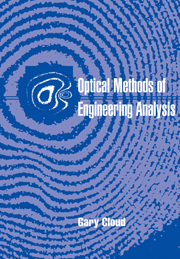Book contents
- Frontmatter
- Contents
- Acknowledgments
- 1 Introduction and orientation
- Part I Optics and interferometry
- Part II Photoelasticity
- 4 Photoelasticity theory
- 5 Basic applied photoelasticity
- 6 Photoelasticity methods and applications
- Part III Geometrical moire
- Part IV Diffraction theory, optical processing, and moire
- Part V Moire interferometry
- Part VI Holographic interferometry
- Part VII Speckle methods
- Author index
- Subject index
6 - Photoelasticity methods and applications
Published online by Cambridge University Press: 12 January 2010
- Frontmatter
- Contents
- Acknowledgments
- 1 Introduction and orientation
- Part I Optics and interferometry
- Part II Photoelasticity
- 4 Photoelasticity theory
- 5 Basic applied photoelasticity
- 6 Photoelasticity methods and applications
- Part III Geometrical moire
- Part IV Diffraction theory, optical processing, and moire
- Part V Moire interferometry
- Part VI Holographic interferometry
- Part VII Speckle methods
- Author index
- Subject index
Summary
This chapter treats several topics that are important not only in photoelasticity but also in other areas of interferometry. For example, many engineering experiments require good knowledge of the viscoelastic properties of materials and how to measure them. The transfer of experimental results from model to prototype is important to anyone contemplating experiments that might involve models, and such experiments are very common. Measurement of exact fractional fringe orders is useful in many applications of interferometry, and the methods used in photoelasticity provide a basis for similar methods in other areas, such as phase shifting in electronic speckle pattern interferometry.
Even so, inclusion of all the material that should appear in a chapter on applied photoelastic interferometry has been problematical because of space limitations and possible perceived distortion of emphasis. A factor is that many optical methods courses still spend a good deal of time on applied photoelasticity, and rightly so because it is an important engineering tool. Industrial users of the book probably need more on the subject than is given in Chapter 5. The coverage, in the end, represents a compromise among utility, educational value, length limitations, and the overall balance of the book; and it should be viewed in that light.
Finally, many of the references cited in the preceding two chapters are relevant to this one, even though they might not be mentioned specifically. The literature on techniques of photoelasticity is very large, and practitioners of the art will need to examine a good deal of it. Burger (1987) provides a particularly extensive and valuable list of references along with a wealth of technical detail.
- Type
- Chapter
- Information
- Optical Methods of Engineering Analysis , pp. 101 - 144Publisher: Cambridge University PressPrint publication year: 1995
- 1
- Cited by

